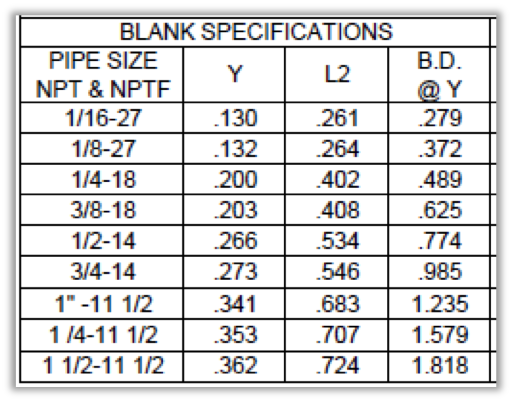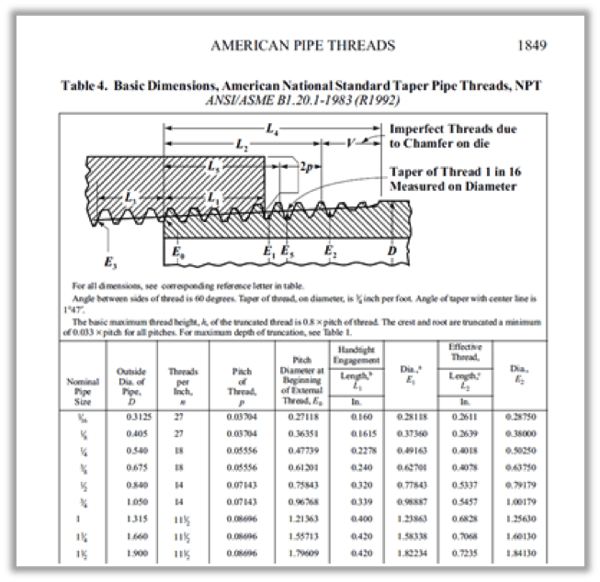The United States uses ANSI’s American National Standard Pipe Thread Standards to regulate the formation and sizes of screw threads on manufactured parts with straight or tapered threads. These standards ensure that separate pieces fit together properly for specialized attributes such as pressure-tight sealing and rigidity.
Pipe Threads
Pipe thread standardization is complex. Historical precedents, which differ from country to country and from industry to industry, impact which pipe thread standards manufacturers must follow for different projects. For example, garden hoses and fire hoses have different thread standards—even British and American garden hoses of the same type may have different thread standards. However, pipe threads are generally sorted into tapered pipe threads and parallel straight pipe threads.
Tapered Pipe Threads
For liquid and gas applications, the pipes need to be leak-proof. Tapered threads are the preferred option because they better prevent leaks. The tapered design helps the male and female ends form a seal when torques together as the flanks of the threads compress against each other, even without the addition of sealant. Two standards that govern the majority of tapered pipe threads are the American National Standard Taper Pipe Thread (NPT) and the British Standard Pipe Taper Thread (BSPT).
Pipes that are compatible under one set of standards aren't compatible with the other. NPT threads have flattened peaks and valleys and a 60° angle, whereas BSPT threads are rounded and threaded at a 55° angle. Most pipes in the United States and Canada follow NPT standards, while pipes in the UK and Europe follow BSPT standards.
National Standard Taper Pipe Threads Size NPT Chart
The NPT standards oversee both external and internal pipe threads, so both the male and female pipe ends are consistent and predictable. Every NPT thread has a taper rate of ¾-inch per foot, or 1/16-inch per inch of length. The taper rate is determined by comparing the change in thread diameter over the length of the pipe. The taper angle itself Is 1° 47" 24"" (1.7899°).
Manufacturers produce NPT-standard pipes and fittings in these commonly preferred sizes:
| Nominal Pipe Size | O.D. of Pipe (D) | Threads/in. (n) |
| 1/16 | 0.3125 | 27 |
| 1/8 | 0.405 | 27 |
| 1/4 | 0.540 | 18 |
| 3/8 | 0.675 | 18 |
| 1/2 | 0.840 | 14 |
| 3/4 | 1.050 | 14 |
| 1 | 1.315 | 11.5 |
| 1 1/4 | 1.660 | 11.5 |
| 1 1/2 | 1.900 | 11.5 |
| 2 | 2.375 | 11.5 |
In some specialized applications, such as air compression, there's a demand for pipes that are smaller than 1/8 of an inch. However, it's very rare for pipes with tapered threads to be over 2 inches and they often use other methods of joining.
Thread Gaging and Blank Specifications

High-quality gauging methods are a necessity to produce pipes, connectors, and fittings that meet strict NPT and BSTP standards. Straight and tapered pipes each need different blank specifications in order to accommodate the finishing steps.
Straight threading processes machine the blank's diameter to no more than 0.002 inches, or the maximum pitch diameter. The equipment then rolls the thread until the diameter falls at a specific amount within the pitch diameter's maximum and minimum. The equipment also adjusts the blank diameter until the major diameter falls within the maximum and minimum.
Tapered thread machining is slightly more complicated. The following chart shows the specifications for tapered threads.

Rolling on a Tapered Pipe Thread
To create a tapered pipe thread, a part blank diameter must be machined to match the specifications in the NPT sizing chart. It must match the angle of 1° 47" while also having the appropriate blank diameter at different points. Once the blank is appropriately sized, manufacturers can roll the thread until the diameter falls within the L1 and L2 (specified on the NPT sizing chart) gauge specifications.
Measure Features on a Tapered Pipe Thread
Tapered pipe threads have several distinct measurements that need to be accurate and well-maintained throughout the production process. These include:
- Blank diameters, which are measured with a comparator or micrometers
- Pitch diameter, which uses L1 and L2 gauges to verify the corresponding pitches
- Major diameters, which are verified with a six-step process
Manufacturers also use rings to inspect the gaging and sizes of tapered threads. Those rings include:
- NPT L1 rings, which inspect the hand tight engagement and test if parts sit flush to the end of the ring within an acceptable margin. An NPTF L1 ring handles the same function.
- NPTF L2 rings, which inspect wrench engagement threads and control the thread tolerances tightly
- NPTF six-step gauges, which check the crest truncation of external threaded pipes or fittings. These gauges are used with L1 and L2 ring gauges.
 |
 |
 |
Contact CJWinter for Thread Rolls and Attachments
It's important to choose the right thread rolls and tools for creating high-quality fittings. Well-matched threads create better seals for systems that contain gas or liquid fluids, and understanding tapered threads is an essential element of that. Contact CJWinter for more information about our capabilities.






